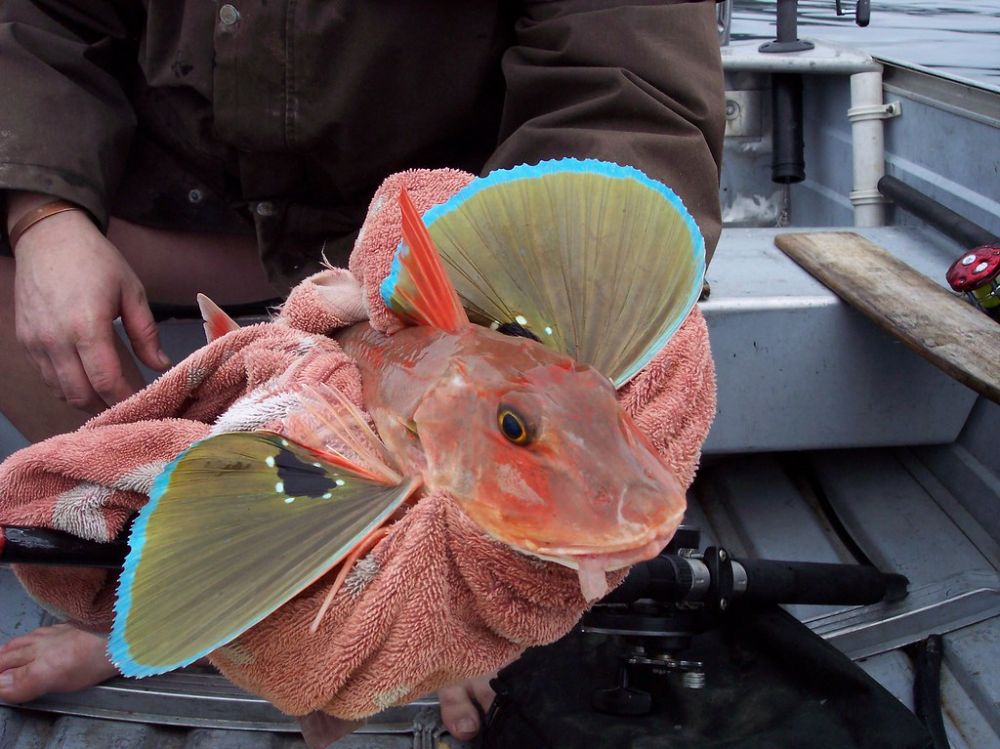
Read the article with FishingTheSpot: the gurnard fish
Keep an eye on this subject!
Thousands of species spotlights and techniques but also all the local information about your city!



Meet other anglers near you and share your fishing fishing trips, afoot or on a boat, at sea or in freshwater
See the fishing tripsThe Gurnard Fish

from August to April
200 g
Did you fish
this species this month?
The Gurnard Fish belongs to the Triglidae family. their sizes vary from 250g to 1 kg. The maximum size recorded is 6 kg. The maximum age that was reached and measured in this fish was 15 years. It is fished in August in April.
The gurnard can be identified by the way he moves on the bottom using the first 3 rays of his pectoral fins transformed into locomotor appendages allowing him to "walk" on the seabed. The longest rays of the pectoral fin reach the beginning of the anal fin. This fin, when the individual begins to swim, shows its underside decorated with a bright blue border. It may also have a fairly central black area with blue spots. The bluish coloration of the pectoral fades with age. This fish has two distinct ridges, the first of which is quite short. With a maximum height of 75 cm, but usually not exceeding fifty centimeters, it is the largest representative of the family. Its maximum referenced weight is 6 kg. As with other gurnards, the head is massive and armored. It has a snout extending far forward and ending in a curvature or a slight indentation. The spines on the lids and pre-lids are quite short. The general color varies from grey to reddish to brown with varying degrees of dark spots. Her belly is white. Small scales give it a very smooth looking integument. The lateral line, which is similar in color to that of the body, shows only a slight relief.
The Gurnard fish lifestyle
Equipped with sensory receptors, its locomotor rays also allow it to locate its prey in the soft bottoms, while its rostrum allows it to search the sediments. Young gurnards feed mainly on crustaceans and small worms buried in the sand. When they reach about 30 centimeters, they feed on crabs. Finally, adults feed in winter on bottom fish and cephalopods, and in summer on small coastal bottom or open-water fish. Indeed, despite their appearance, gurnards are excellent swimmers.
The breeding period extends from December to February/April in the Mediterranean, and from May to June off Brittany. Egg laying is split, 150,000 eggs can be laid, they are pelagic and spherical in shape.
The Gurnard fish habitat
The gurnard prefers sandy, muddy or gravel bottoms, from 20 to more than 300 m (318 m in the Ionian Sea). Most often it is between 50 and 250 m. It approaches the coasts in summer, sometimes penetrating estuaries, and reaches deeper depths in winter, beyond 80 m. Young people are occasionally observed near the shore. It can withstand a fairly wide water temperature range: from 8 to 24 °C.
The gurnard is present in the Atlantic Ocean, from Norway to the White Cape, and in the Mediterranean, especially in its western part, as well as in the Black Sea.
The Gurnard fish angling
The gurnard is caught by trawl, and sold fresh, its flesh is highly valued. It is fished from August to April.


